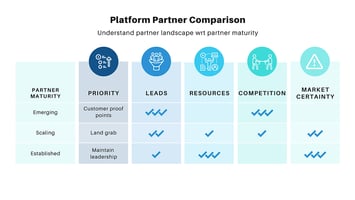In our previous article, we explored the benefits of strategic partnerships between tech services...
Strategy and Tactics: How To Create Coherence in Business Execution

Strategy without tactics is the slowest route to victory. Tactics without strategy is the noise before defeat. - Sun Tzu
In our blog post "Why An ETS Is The Perfect Starter Business", we discussed what an emerging tech services business (ETS) is and why if you are building a tech services business, you should build it as an ETS. The focus on your particular technology will constitute a fundamental part of your vision and strategy. However, the founder of an ETS startup needs to develop tactics to execute this strategy. They will need to translate the overarching strategy into specific tactics and actions. In this article, we will break down the relationship between visionary strategy and executable tactics.
Strategy Without Execution
Tactics are the building blocks of execution. They translate strategy into concrete actions, making it possible to achieve strategic objectives. Strategy is about setting direction, not undertaking the journey. It’s not something that can sit on a shelf never being read again. That isn’t a strategy. That is a pipe dream. For something to be your strategy, it must color every action you and your team take.
Execution Without Strategy
On the flip side, execution needs to be guided by a strategy. Organizations that focus solely on execution without a guiding vision often experience misaligned efforts, wasted resources, and a lack of clarity. These companies achieve short-term successes, but they struggle to translate these short-term successes into long-term systems because they lack coherence.
Strategy And Execution In Alignment
Your strategy is an engine that will tell you how to create tactics and which tactics you should expect to be more effective. Even if particular tactics fail, your strategy will ensure that the tactics are coherent, allowing you to work around your failures while creating continuous leverage to achieve outsized returns on your tactics.

What Makes A Strategy Executable
We referenced coherence a few times in this article. So, what makes a strategy coherent? To be coherent, a strategy needs to be opinionated, focused on the activities that create leverage off each other, and backed with clarity for the whole team.
Opinionated
If there is one key element to make a strategy meaningful it is that it needs to be opinionated. In other words the strategy must say no to most things allowing you to focus. Resources are always finite. Strategy is ultimately about the allocation of these resources. For any strategy to be meaningful it must identify the areas that the strategy is focusing on and ensure resources are only used for the focus. If your strategy is not enabling you to say no, then you are not making a strategic decision.
Creates Leverage
A strategy needs to be opinionated because it creates leverage. To be successful, a strategy needs to identify a focused domain so we can gain increasing leverage in that domain. Efforts that align with the strategy will amplify the organization's strengths and multiply the impact of its resources, creating a snowball effect.
Backed With Clarity
You need clarity on your strategy. It starts with you, the leader. You need to have a definite thesis about the way you see the world, where the world will be, and how you are going to create value during this change. This thesis gives you clarity on the opportunity you are trying to seize. Armed with this understanding, you will be fully committed yourself and be able to get the commitment of your team and organization. Everyone will also have an understanding of the actual objectives and be able to consistently make independent decisions that reinforce other parts of the organization, creating leverage.
Flux7 Case Study
To clarify how this strategy comes into play for an emerging tech services startup, we would like to talk about our previous venture, Flux7 Labs. Initially, we had no direction and were two smart guys who thought we could solve any problem. We did know there was hype in the market for cloud and data and started exploring those fields, not understanding either. We blindly did many experiments but realized that talking about developer productivity enabled with automation on the cloud resonated with many customers. So, we decided to double down on DevOps on AWS.
Our thesis was that developer time is the most expensive resource a company has, and with automation, we can greatly increase developer productivity. AWS, with its cloud offering, was the best platform to provide this automation. So, we deepened our ties with AWS, building relationships with executives, account managers, and product teams. We focused our marketing on AWS to create a consistent understanding. We knew the talent wasn't there, so we took it upon ourselves to take developers and train them. Something we could do because we had tightened the scope of what we do. We knew where to go for networking and became respected thought leaders. We created an assessment platform that turned the mystery of the cloud into a puzzle. We could sidestep the 800-pound gorillas in consulting because they did not have the deep subject matter expertise we did. Finally, in 2019, NTT Data Services acquired us because they needed an AWS practice.
We made some mistakes. The biggest strategic mistake we made was that we focused too much on teaching you how to fish, even though many of our customers would have preferred a managed services agreement. Overall, the sharp focus on developer productivity on AWS was a huge success for us. This is why we recommend every firm providing tech services focus on a specific emerging technology. Emerging tech by itself will define a large portion of your strategy.
How Vixul Handles This Interplay
With this article we showed you the interaction of strategy and execution. We have built the Vixul Accelerator with an understanding of this interplay. We start off at a very strategic level and help you define your vision, mission, values, and positioning. But we back this up by teaching you the operational elements you need to put in place to run and manage your organization and identifying the tactics you will use to test out your positioning thesis. In addition we continue to work with you, guiding you on growing your company. Helping you translate your strategy into execution and revising the strategy as needed. If you think you are struggling with developing your vision or executing it, we would love to have you apply for our a25-1 cohort. You can find the application for our upcoming cohort here.




